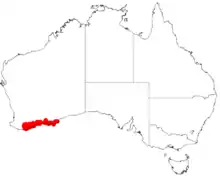| Acacia aemula | |
|---|---|
| Scientific classification | |
| Kingdom: | Plantae |
| Clade: | Tracheophytes |
| Clade: | Angiosperms |
| Clade: | Eudicots |
| Clade: | Rosids |
| Order: | Fabales |
| Family: | Fabaceae |
| Subfamily: | Caesalpinioideae |
| Clade: | Mimosoid clade |
| Genus: | Acacia |
| Species: | A. aemula |
| Binomial name | |
| Acacia aemula | |
 | |
| Occurrence data from AVH | |
Acacia aemula is a shrub belonging to the genus Acacia and subgenus Alatae. It is native to an area along the south coast of Western Australia.[1][2]
Description
The shrub is prostrate to semi-prostrate, open branched and rush-like that typically grows to a height of 0.2 to 0.4 metres (0.66 to 1.3 ft). It produces white-cream flowers from May to June[1]
Taxonomy
The species was first formally described by the botanist Bruce Maslin in 1995 in the work Acacia Miscellany 13. Taxonomy of some Western Australian phyllocladinous and aphyllodinous taxa (Leguminosae: Mimosoideae) as published in the journal Nuytsia. It was later reclassified as Racosperma aemulum by Leslie Pedley in 2003 then returned to the genus Acacia in 2006.[2]
Two subspecies are recognized :
Distribution
It is found along the south coast of Western Australia in the Great Southern and Goldfields-Esperance regions extending from around Albany east to Cape Arid National Park where it grows among granite outcrops and flats near creeks in sandy soils.[1]
See also
References
- 1 2 3 "Acacia aemula". FloraBase. Western Australian Government Department of Biodiversity, Conservation and Attractions.
- 1 2 "Acacia aemula Maslin". Atlas of Living Australia. Global Biodiversity Information Facility. Retrieved 7 March 2016.
- ↑ "Acacia aemula subsp. aemula". FloraBase. Western Australian Government Department of Biodiversity, Conservation and Attractions.
- ↑ "Acacia aemula subsp. muricata". FloraBase. Western Australian Government Department of Biodiversity, Conservation and Attractions.